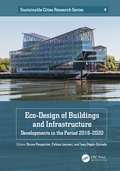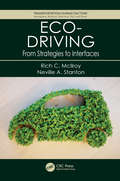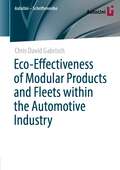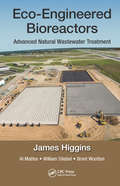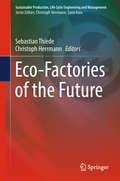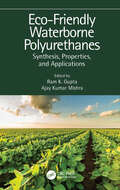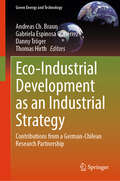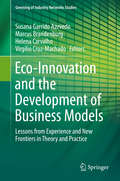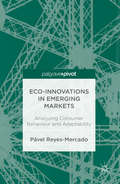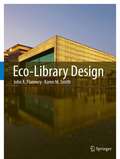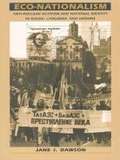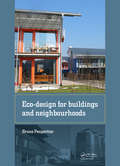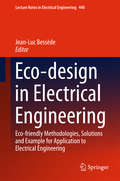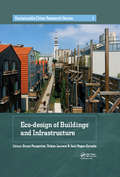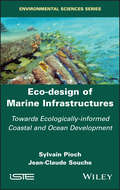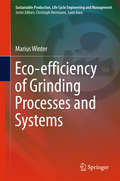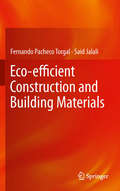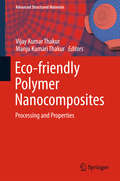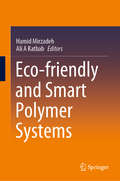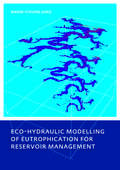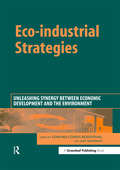- Table View
- List View
Eco-Design of Buildings and Infrastructure: Developments in the Period 2016–2020 (Sustainable Cities Research Series #4)
by Bruno Peuportier Fabien Leurent Jean Roger-EstradeThe Chair Eco-design of buildings and infrastructure, a partnership between three engineering colleges (MINES ParisTech, Ecole des Ponts ParisTech and AgroParisTech) and the VINCI group, aims to create measurement and simulation tools which integrate all the dimensions of eco-design (greenhouse gas emissions, impact on biodiversity and resource levies, etc.) to become real decision-making tools, based on a scientific approach, for all actors in the city (designers, builders and users). This book reviews the second five-year sequence of the Chair, first presenting methodological advances in eco-design: life cycle assessment and quantification of uncertainties; local environmental impacts of transport and biodiversity. The interdisciplinary partnership, also associating the human sciences, shows its interest in taking into account the human factor in the modelling of urban systems. This modelling is based on several numerical simulation tools, presented in the third part. This theoretical set results in more substantial proposals for the renewal of techniques and systems, in terms of energy management strategies in buildings, urban agriculture, participatory data collection and digital transformation in transport. This book is intended for urban planners, local authorities, building owners, architects, design offices, companies, building managers, teacher-researchers and anyone interested in the environmental quality of our living spaces.
Eco-Driving: From Strategies to Interfaces (Transportation Human Factors)
by Neville A. Stanton Rich C. McllroyEco-driving has the potential to save fuel and reduce emissions without having to make any changes to vehicles or road infrastructure. This book provides an in-depth understanding of the contemporary issues in the human factors aspects of eco-driving strategies and interfaces and the effects on driver behaviour. A review of the literature concerning design, behaviour, and energy use led to an exploration of Ecological Interface Design, and the Skills, Rules, and Knowledge (SRK) taxonomy of human behaviour, particularly with regard to haptic information presented through the accelerator pedal. This book explains that eco-driving can be performed by anyone in control of a vehicle.
Eco-Effectiveness of Modular Products and Fleets within the Automotive Industry (AutoUni – Schriftenreihe #164)
by Chris David GabrischThe automotive industry is facing the challenge of reducing its environmental impact to comply with stricter fleet emission regulations. Still, an OEM’s contribution to the targets of the Paris Agreement must consider the entire life cycle of a vehicle, surpassing the targets of the current legislations which focusses on the use stage only. This work presents a concept that identifies the ideal configuration of a modular product system like a vehicle to meet a limited environmental impact at the lowest life cycle costs along the entire life cycle. This optimization is based on the ideal combination of modular product components which are selected by an algorithm based on graph theory.
Eco-Engineered Bioreactors: Advanced Natural Wastewater Treatment
by James Higgins Al Mattes William Stiebel Brent WoottonThis book provides a comprehensive understanding of a highly innovative method of natural wastewater treatment using advanced in-groundbioreactors called Eco-Engineered Bioreactors (EEBs), and traces their evolution from the earliest aerated gravel bed versions once known as Engineered Wetlands (EWs) and now known as BREW Bioreactors (BBRs) all the way to today’s wide slate of aerobic and anaerobic varieties. Treatment using EEBs involves passing wastewaters through excavated basins in which they contact fixed films of microbial consortia on permeable substrate media. Written from the perspective of ecological engineers designing EEBs, this guide covers updated information on the state-of-the-art for EEBs, covering their morphologies, testing methods, designs, operations, and microbiology.
Eco-Factories of the Future (Sustainable Production, Life Cycle Engineering and Management)
by Christoph Herrmann Sebastian ThiedeThis edited monograph presents a selection of research contributions on eco-factories of the future. The topical focus lies on cutting-edge solutions from academia and industry that enable and support companies in their efforts towards sustainable manufacturing. The authors provide an overview over recent developments, aiming at a comprehensive understanding of eco- and cost-efficient manufacturing from machine to factory level. The solutions contributed by leading research institutions and companies have been mostly implemented and evaluated in industrial pilot projects across Europe. The methodological approaches cover topics such as factory planning, manufacturing simulation, energy management as well as life cycle evaluation. The target audience comprises industry experts and decision makers as well as researchers in the field of sustainable manufacturing.
Eco-Friendly Adhesives for Wood and Natural Fiber Composites: Characterization, Fabrication and Applications (Composites Science and Technology)
by Mohammad Jawaid Mohammad Asim Mohammed Nasir Tanveer Ahmed KhanThis book provides an overview of eco-friendly resins and their composite materials covering their synthesis, sources, structures and properties for different industrial applications to support the ongoing research and development in eco-friendly and renewable commercial products. It provides comparative discussions on the properties of eco-friendly resins with other polymer composites. It is a useful reference on bio-based eco-friendly polymer resins, wood-based composites, natural fibers and biomass materials for the polymer scientists, engineers and material scientists.
Eco-Friendly Waterborne Polyurethanes: Synthesis, Properties, and Applications
by Ram K. GuptaThe polyurethane industry is among the fastest growing, with polyurethanes used in consumer as well as industrial sectors. Waterborne polyurethanes (WPUs) exhibit many advantages over conventional volatile organic compounds (VOCs) based polyurethanes and have emerged as an environmentally friendly alternative. WPUs offer an opportunity to use sustainable raw materials to produce environmentally sustainable polymers, particularly, polyols derived from vegetable oils. Eco-Friendly Waterborne Polyurethanes: Synthesis, Properties, and Applications provides state-of-the-art knowledge of the synthesis, application, and property enhancement of WPUs. Covers various types of eco-friendly materials and technologies used to synthesize WPUs Presents an overview and applications of WPUs in several advanced research areas Provides fundamentals of synthetic processes and their chemistries for specific applications Elaborates on advanced approaches used to convert renewable resources into polymers Offers new direction to scientists, researchers, and students to better understand the chemistry, technologies, and applications Written for polymer chemists, materials scientists, and other researchers and industry, this book serves as a comprehensive reference for readers interested in the development and application of sustainable polymers.
Eco-Industrial Development as an Industrial Strategy: Contributions from a German-Chilean Research Partnership (Green Energy and Technology)
by Thomas Hirth Andreas Ch. Braun Gabriela Espinosa Gutiérrez Danny TrögerThis book reports on the results of a 6-year international collaboration between four universities such as the Karlsruhe Institute of Technology (Germany), the Universidad de Chile, the Universidad Austral de Chile and the Universidad de Concepcion (Chile) on the topic of Eco-Industrial Development, i.e. on how industry can learn from ecosystems in order to increase its sustainability. On the one hand, this book presents the findings of the projects run by the network of researchers from Chile and Germany, including chapters on renewable energy production, circular economy, sustainable agriculture, and social and environmental impact assessment, among others. On the other hand, it highlights the importance of international academic collaboration in order to achieve sustainable transformations in industry, while also providing insights into the particular challenges and opportunities of eco-industrial development in Chile. All in all, this book provides both academics and professionals with a timely snapshot on principles and best practices for industrial sustainability and sustainable development.
Eco-Innovation and the Development of Business Models
by Susana Garrido Azevedo Marcus Brandenburg Helena Carvalho Virgílio Cruz-MachadoEnvironmental challenges such as pollution, climate change, water and natural resources depletion and dwindling bio-diversity are true threats to the survival of our civilization, forcing us to learn how to act now. Fortunately this is exactly what this book does: presenting real life cases, along with theory, methodologies and tools demonstrating how eco-innovation can support sustainable economic growth and save our planet for future generations. Following an introduction describing developments and directions of eco-innovation, Section One discusses Models and Frameworks Supporting Eco-Innovation, with chapters on search strategy for radical eco-innovation; and systematic eco-innovation with TRIZ Methodology. Section Two offers surveys and case studies showing eco-innovation in practice, including a sketch of the eco-innovative landscape in the Brazilian Cellulose, Paper and Paper Products Industry; efforts to eco-innovate among large Swedish companies; progress towards joint product-service business models and more. The third section surveys future directions and emerging trends, among them a new methodology for eco-friendly construction; the development of lightweight small inter-island ferries in Scandinavia and BioTRIZ: a win-win methodology for eco-innovation. The book explores eco-innovation as a framework for supporting the development of new business models which consider the entire business ecosystem, on the way to a sustainable world. Moreover, it explores the eco-innovation process in cross-national and cross-sector perspective.
Eco-Innovations in Emerging Markets
by Pável Reyes-MercadoThrougha comprehensive analysis of cognitive factors and eco-innovation attributes,this book provides an understanding into why and how renewable energytechnologies are adopted in an emerging market. Drawing on theories such astheory of reasoned action and theory of planned behaviour, Eco-Innovations in Emerging Markets proposes an extended cognitivemodel to analyse consumer behaviour in this area. Through the use of advancedstatistical techniques such as Partial Least Squares, the book presents empiricaldata and discusses the implications they pose for policy makers and corporatemanagers.
Eco-Library Design
by John A. Flannery Karen M. SmithThe ancient pairing of architecture and books has always been an interesting topic for debate, and the increasing popularity of electronic books has recently added fuel to the fire. However, the bonfires built for the printed version remain unlit. Research undertaken for this publication suggests that the traditional reading room is currently enjoying a renaissance in many different guises, with print and digital media enjoying a symbiotic relationship. The digital revolution is just one of the many challenges faced by the library architect. To satisfy the varied requirements of library users, flexible, future proof, indoor and outdoor spaces must now support both passive and active pursuits. These often contrasting demands can vary dramatically from quiet, contemplative reading to audible public performance. This publication explores in detail the evolution of the eco-library, focusing on how design teams cope with diminishing resources in diverse geographic and climatic conditions. The featured projects demonstrate measurable reductions in both construction and operating costs through innovative designs that utilise the ecology of a selected site in a positive way. A library development will now inevitably seek to lead by example, visibly demonstrating sound environmental practice, and providing an enhanced user experience for increasingly more discerning patrons. Eco-Library Design provides a worldwide perspective on 21st century trends in library architecture.
Eco-Materials and Green Energy for a Sustainable Future
by Amit Soni Dharmendra Tripathi Jagrati Sahariya Kamal Nayan SharmaEco-Materials and Green Energy for a Sustainable Future emphasizes the synergy between eco-materials and green energy solutions, highlighting their combined power to reduce carbon emissions, conserve resources, and create a more resilient and sustainable future. It provides a detailed discussion on cutting-edge green energy technologies and their potential to transform the energy landscape.Covering a range of applications and emerging technologies that are moving toward sustainable and green energy, this book includes topics on nano-batteries, nanoparticle treatments of toxic textile industry wastewater, and green building materials. It explores thin-film solar cells and luminescent materials in solar energy. This book considers green synthesis methods, such as plant extracts and microorganisms, with applications in regenerative medicine.This book will interest researchers and senior undergraduate and graduate students studying renewable energy sources, green materials engineering and chemistry, and sustainability.
Eco-Nationalism: Anti-Nuclear Activism and National Identity in Russia, Lithuania, and Ukraine
by Jane I. DawsonEco-nationalism examines the spectacular rise of the anti-nuclear power movement in the former Soviet Union during the early perestroika period, its unexpected successes in the late 1980s, and its substantial decline after 1991. Jane I. Dawson argues that anti-nuclear activism, one of the most dynamic social forces to emerge during these years, was primarily a surrogate for an ever-present nationalism and a means of demanding greater local self-determination under the Soviet system. Rather than representing strongly held environmental and anti-nuclear convictions, this activism was a political effort that reflected widely held anti-Soviet sentiments and a resentment against Moscow's domination of the region--an effort that largely disappeared with the dissolution of the USSR.Dawson combines a theoretical framework based on models of social movements with extensive field research to compare the ways in which nationalism, regionalism, and other political demands were incorporated into anti-nuclear movements in Russia, Lithuania, Ukraine, Armenia, Tatarstan, and Crimea. These comparative case studies form the core of the book and trace differences among the various regional movements to the distinctive national identities of groups involved. Reflecting the new opportunities for research that have become available since the late 1980s, these studies draw upon Dawson's extended on-site observation of local movements through 1995 and her unique access to movement activists and their personal archives.Analyzing and documenting a development with sobering and potentially devastating implications for nuclear power safety in the former USSR and beyond, Eco-nationalism's examination of social activism in late and postcommunist societies will interest readers concerned with the politics of global environmentalism and the process of democratization in the post-Soviet world.
Eco-design for Buildings and Neighbourhoods
by Bruno PeuportierA growing number of urban inhabitants are aware of pressing environmental concerns. This book aims to provide information about relevant environmental quality criteria in urban construction settings, before methods are proposed for assessing these criteria. These will be extremely helpful to eco-building designs, commencing from the very early stag
Eco-design in Electrical Engineering: Eco-friendly Methodologies, Solutions and Example for Application to Electrical Engineering (Lecture Notes in Electrical Engineering #440)
by Jean-Luc BessèdeThis book addresses eco-design, a major tool for reducing the environmental impacts of products, services and systems in the context of sustainable development. It covers four key aspects of eco-design, applied to electrical engineering. First, it describes current and future methodologies and standards, including regulations, which apply to electrical engineering. In turn, the second chapter is devoted to energy systems and planning, including constraints on the insertion of equipment into the grid. Components such as transformers and cables, their eco-design characteristics and impacts, and their potential to improve the environmental impacts of networks are described in the third chapter. Lastly, the fourth chapter deals with materials in terms of their performance and ecological impact. In the case of electrical equipment, the eco-design approach is also connected to the development of renewable energies and energy efficiency.
Eco-design of Buildings and Infrastructure (Sustainable Cities Research Series)
by Bruno Peuportier, Fabien Leurent and Jean Roger-EstradeThe Chair on Ecodesign for buildings and infrastructures was created by ParisTech in partnership with VINCI with the aim of developing evaluation and simulation tools that integrate all ecodesign aspects (e.g. greenhouse gas emissions, impact on biodiversity, depletion of resources, etc.) and provide genuine decision-aid instruments, based on a scientific approach, to all those involved in the urban environment (i.e. designers, builders and users). The present book takes stock of five years of research under the Chair. It starts by presenting some methodological bases of ecodesign, life cycle assessments, impact studies, and methods for planning and transport. Several specific subjects are then covered, i.e. public transport, parking, road traffic, the environmental profile of building materials, building retrofits, energy management, and biodiversity. The last part of the book sets out how the knowledge and tools developed under the Chair were applied to a case study: Cité Descartes in Marne la Vallée (Ile de France). This work is aimed at urban planners, local authorities, contracting clients, architects, engineering firms, contractors, building managers, research lecturers, and anyone interested in the environmental quality of the places we live in.
Eco-design of Marine Infrastructures: Towards Ecologically-informed Coastal and Ocean Development
by Sylvain Pioch Jean-Claude SoucheThis book offers an insight into how to create aesthetically pleasing, environmentally integrated, multi-functional developments in the ocean or on the coastline.Eco-design of Marine Infrastructures provides practical and realistic solutions for delivering projects that strive to minimize negative environmental impacts.Using case studies and examples, this book presents a toolkit of options, allowing decision makers and planners to see what is possible and to make informed choices about the risks and benefits of eco-design. It is intended for researchers, engineers, students and decision makers, or anyone who is curious to see how nature can be integrated into development.
Eco-efficiency of Grinding Processes and Systems
by Marius WinterThis research monograph aims at presenting an integrated assessment approach to describe, model, evaluate and improve the eco-efficiency of existing and new grinding processes and systems. Various combinations of grinding process parameters and system configurations can be evaluated based on the eco-efficiency. The book presents the novel concept of empirical and physical modeling of technological, economic and environmental impact indicators. This includes the integrated evaluation of different grinding process and system scenarios. The book is a valuable read for research experts and practitioners in the field of eco-efficiency of manufacturing processes but the book may also be beneficial for graduate students.
Eco-efficient Construction and Building Materials
by Fernando Pacheco Torgal Said JalaliEco-efficient Construction and Building Materials provides essential reading about materials for the construction industry in the twenty-first century. It covers the latest findings in the field, especially the toxicity aspects, embodied energy, construction and demolition wastes, the use of wastes in concrete, masonry units, materials reinforced with vegetable fibres, earth construction, the durability aspects, and also the importance of nanotechnology to the development of more environmentally-friendly materials. Based on more than nine hundred references, Eco-efficient Construction and Building Materials is of fundamental importance to academics, engineers and architects who are dedicated to the creation of a greener and more holistic construction industry.
Eco-friendly Agro-biological Techniques for Enhancing Crop Productivity
by Rakesh Singh Sengar Ashu SinghAs the world population is exploding and alongside fluctuations in climate is also prevalent, there is an increasing stress on the food requirements of the population. We have an urgent necessity to produce more food in the limited agricultural land. Further, to feed 7 billion people there is a requirement of high yielding crops, without harming environment and limiting the use of unnecessary pesticide and chemical fertilizers. Therefore it has become crucial to develop agri-bio-techniques which are environment friendly and also give high crop productivity. Many countries are evaluating the utility of biotechnology and its role in addressing problems of food security and poverty. Biotechnology is the application of scientific and engineering principles to the processing and production of materials by utilising biological agents. These agents are exploited to provide goods and services. Agricultural biotechnology encompasses a growing list of techniques that range from simple probes to determine a relevant gene from the complete genome to manipulating genes for a desired outcome. Many other popular methods used in the realm of agricultural technology are – gene integration, Marker-assisted breeding, Tissue culture, Gene profiling or association mapping, Metabolomics etc. The fundamental challenge facing the scientific community is how to devise innovative strategies that will bring all developed as well as developing countries into the “biological fold” and to do so in ways that will take full advantage of advances in the biological sciences to curb poverty, improve public health, and promote human development. This book contains information on eco-friendly techniques for high crop productivity and it is a myriad of different techniques and technology used to sustain productivity in crop plants. There are fewer books focusing on large-scale organic farming, molecular farming etc. Multidisciplinary research and literature is needed to deliver knowledge and products into the marketplace which fulfil these requirements. The present book is a collection of literature contributed by experts, scientists, professors, and researchers from around the world, it emphasizes work of concerned scientist and his choice of techniques used for enhancement of agricultural production. This book analyses the use of modern techniques to increase crop yields, production, and risk of hunger linked to socioeconomic scenarios.
Eco-friendly Polymer Nanocomposites
by Vijay Kumar Thakur Manju Kumari ThakurThis book contains precisely referenced chapters, emphasizing environment-friendly polymer nanocomposites with basic fundamentals, practicality and alternatives to traditional nanocomposites through detailed reviews of different environmental friendly materials procured from different resources, their synthesis and applications using alternative green approaches. The book aims at explaining basics of eco-friendly polymer nanocomposites from different natural resources and their chemistry along with practical applications which present a future direction in the biomedical, pharmaceutical and automotive industry. The book attempts to present emerging economic and environmentally friendly polymer nanocomposites that are free from side effects studied in the traditional nanocomposites. This book is the outcome of contributions by many experts in the field from different disciplines, with various backgrounds and expertises. This book will appeal to researchers as well as students from different disciplines. The content includes industrial applications and will fill the gap between the research works in laboratory to practical applications in related industries.
Eco-friendly Polymer Nanocomposites
by Vijay Kumar Thakur Manju Kumari ThakurThis book contains precisely referenced chapters, emphasizing environment-friendly polymer nanocomposites with basic fundamentals, practicality and alternatives to traditional nanocomposites through detailed reviews of different environmental friendly materials procured from different resources, their synthesis and applications using alternative green approaches. The book aims at explaining basics of eco-friendly polymer nanocomposites from different natural resources and their chemistry along with practical applications which present a future direction in the biomedical, pharmaceutical and automotive industry. The book attempts to present emerging economic and environmentally friendly polymer nanocomposites that are free from side effects studied in the traditional nanocomposites. This book is the outcome of contributions by many experts in the field from different disciplines, with various backgrounds and expertises. This book will appeal to researchers as well as students from different disciplines. The content includes industrial applications and will fill the gap between the research works in laboratory to practical applications in related industries.
Eco-friendly and Smart Polymer Systems
by Hamid Mirzadeh Ali A KatbabThis proceedings book presents the main findings of the 13th International Seminar on Polymer Science and Technology ( ISPST 2018), which was held at Amirkabir University of Technology, Tehran, on November 10–22, 2018. This forum was the culmination of more than three decades of academic and industrial activities of Iranian scholars and professionals, and the participation of many notable international scientists, in covering various important polymer-related subjects of concern to Iran and the world at large, including polymer synthesis, processing and properties, as well as issues concerning polymer degradation, stability, and environmental aspects. For the past half a century, the growing concern for advancing human health, quality of life, and – especially in the last few decades – avoiding and combating environmental pollution have shaped and driven scientific activities geared toward the creation of smart materials that are compatible with the human body, and have prompted scientists and technologists to pursue research using natural and sustainable sources. This book highlights efforts to responsibly address the problems caused by, and which can potentially be solved by, polymers and plastics.
Eco-hydraulic Modelling of Eutrophication for Reservoir Management
by Nahm-chung JungThis study presents an systematic approach to water quality assessment, hybrid modelling and decision support for eutrophication management in deep reservoirs. It is found that during the summer monsoon the catchment runoff into the Yongdam reservoir induces a transfer of pollutants from a middle stratified layer to the surface layer. Although the
Eco-industrial Strategies: Unleashing Synergy between Economic Development and the Environment
by Judy MusnikowEco-industrial development is born from the realisation that the places where we work waste too much and unnecessarily pollute the land, air and water. This book explores the key issues involved in developing eco-parks and identifies the stakeholders and their roles in such projects.
